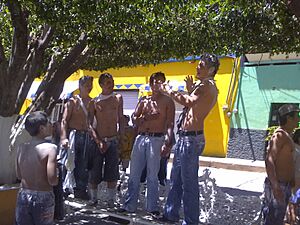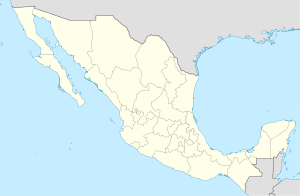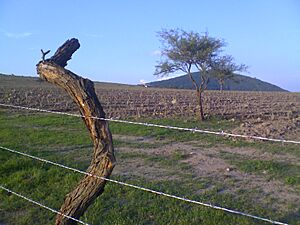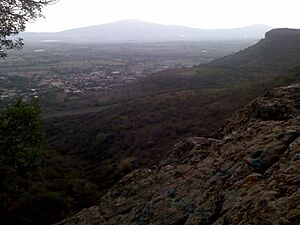Zapotlán del Rey facts for kids
Quick facts for kids
Zapotlán del Rey
|
|
|---|---|
|
Municipality and town
|
|
| Country | |
| State | Jalisco |
| Area | |
| • Total | 400 km2 (200 sq mi) |
| • Town | 1.46 km2 (0.56 sq mi) |
| Population
(2020 census)
|
|
| • Total | 19,279 |
| • Density | 48/km2 (125/sq mi) |
| • Town | 3,330 |
| • Town density | 2,281/km2 (5,907/sq mi) |
| Time zone | UTC-6 (Central Standard Time) |
| • Summer (DST) | UTC-5 (Central Daylight Time) |
| Area code(s) | 391 |
| Website | http://www.zapotlandelrey.jalisco.gob.mx/index.html |
Zapotlán del Rey is a town and municipality in Jalisco, a state in west-central Mexico. The municipality covers an area of 400 square kilometers (about 154 square miles).
In recent years, this town became known for local stories about possible extraterrestrial sightings. People reported seeing strange things near Technical High School No. 95 and farms nearby. Similar stories are also told in nearby cities like Ocotlán, Jalisco.
As of 2005, the municipality had a total population of 16,274 people.
Contents
What's in a Name?
The name Zapotlán comes from the Nahuatl word "Tzapotlán." This means "place where sapotes are plentiful." Sapotes are a type of fruit tree.
A Look Back in Time
When Spanish explorers first arrived, the area was home to the Tecuexe and Nahua tribes. They spoke a dialect called Tepecuexe. No one knows exactly when the town was first founded. The first people lived northwest of the current town, on a hill called "La Coronita" (The Little Crown).
Spanish Arrival
In 1529, a Spanish leader named Nuño de Guzmán sent Pedro Almíndez Chirino to explore and conquer the eastern and northern parts of the region. Almíndez arrived in Tzapotlán. It was the King of Spain's birthday, so he named the place Zapotlán del Rey (Zapotlán of the King). This name is still used today. As a sign of his visit, he placed a wooden cross where the parish church's courtyard is now.
In 1537, a Spanish encomendero (a person given control over a group of native people) named Jorge Simón de Verapaz arrived. He tried to force some native people to move and help found Santa Mónica de La Barca. But they didn't want to go. So, Jorge Simón set fire to a neighborhood called Tepeltac to make them leave. The group that founded La Barca was known for their colorful clothes and for playing an instrument called a chirimia. After the Spanish Conquest, the native people here faced slavery and mistreatment under the Spanish encomenderos.
Important Historical Moments
On November 11, 1810, the famous Mexican leader Miguel Hidalgo passed through Zapotlán del Rey. He was leading his army after a big win at the Battle of Monte de las Cruces. He was on his way to Guadalajara to meet up with another rebel leader, José Antonio Torres.
In 1888, Zapotlán del Rey was part of Tototlán. By 1890, it was a smaller part, or borough, of Tototlán and was considered a town. It belonged to the Third Canton of La Barca. Then, on January 9, 1913, Zapotlán del Rey officially became its own municipality (a type of local government area).
The Coat of Arms
The coat of arms is like a special symbol for Zapotlán del Rey. It has a French shape and is divided into two main parts.
What the Coat of Arms Shows
- In the top part, you can see a landscape with the "La Coronita" hill in the background. There's also a sapote tree with the words "Zapotl = sapote" and "Tlan = place" written below it. In the front, there's a desk with an open book, an inkwell, and a pen.
- The bottom part shows an ear of corn, a wheat stalk, a bull, a cow, and a tractor working in a field.
- Around the edge, it says: "DEMOCRACIA, CULTURA, PROGRESO" (Democracy, Culture, Progress).
- At the very top, there's a brown double-headed eagle wearing a gold crown with jewels.
- The eagle holds a gold ribbon in its claws that says "ZAPOTLAN DEL REY."
What the Symbols Mean
Every part of the coat of arms tells a story about Zapotlán del Rey:
- The La Coronita Hill shows where the first people, the Naho Tecuexes, lived.
- The sapote tree and the words "zapotl" and "tlan" explain the town's name: "place where sapotes are plentiful."
- The book, inkwell, and pen represent education, which is very important to the people here.
- The corn, wheat, animals, and tractor show that farming and raising animals are big parts of the town's economy.
- The words "DEMOCRACIA, CULTURA, PROGRESO" are the town's motto.
- The double-headed eagle, crown, and gold ribbon remind us of the Spanish conquest in 1529. Pedro Almíndez Chirinos named the town Zapotlán del Rey in honor of the King of Spain.
- The main colors of the shield are brown, green, and gold.
Where is Zapotlán del Rey?
Location and Neighbors
Zapotlán del Rey is in the southeastern part of Jalisco. It's about 1550 meters (5085 feet) above sea level.
It shares borders with several other municipalities:
- To the North: Zapotlanejo and Tototlán
- To the East: Tototlán and Ocotlán
- To the South: Ocotlán and Poncitlán
- To the West: Poncitlán, Juanacatlán, and Zapotlanejo
Land and Water
The land in Zapotlán del Rey is mostly flat (53%), with some rugged areas (27%) and semi-flat areas (20%). The soil is made up of different types of rocks and lake formations.
The municipality covers about 32,090 hectares (79,296 acres). A lot of this land is used for farming and raising animals. Some is for forests, and a small part is for the town itself.
The main river is the Río Santiago. There are also several streams like Agua Caliente and El Sauz. You can find dams like La Colonia and La Cañada, and natural springs too.
Weather
The climate here is semi-dry. Winters and springs are dry, and it's generally semi-warm. The average temperature is about 20°C (68°F). It can get up to 28°C (82.5°F) and as low as 12.5°C (54.5°F). The area gets about 819.1 millimeters of rain each year. There are usually about 12 days with frost. Winds mostly blow from the West from January to May, and from the East from June to December.
Plants and Animals
The plants in Zapotlán del Rey include pine trees, oak trees, natural grasses, kidneywood, and tepehuaje. There aren't really big forests.
You might see animals like deer, rabbits, hares, and squirrels. There are also some reptiles and many different kinds of birds.
How People Make a Living
The economy of Zapotlán del Rey is based on several activities:
- Raising Animals: People raise cattle, horses, goats, and pigs. There are also beehives for honey.
- Farming: Important crops include corn, sorghum, wheat, chickpeas, and agave (used to make tequila).
- Shopping: Most shops sell everyday items and a variety of other goods.
- Factories: The main industry is manufacturing. Outside the town, there's a factory that makes and bottles tequila called Destiladora de Agave Hacienda Los Huajes.
- Services: Many people work in services like technical support, community services, personal care, and administrative jobs.
- News: There's a local newspaper called El Informativo de Zapotlán del Rey.
Learning and Schools
Zapotlán del Rey has schools for different age groups:
- Preschool
- Primary School
- Secondary School: Technical Secondary School No. 95 is a well-known school here.
- Preparatory School: There's also a high school managed by the University of Guadalajara.
Fun Things to See and Do
There are many interesting places to visit in Zapotlán del Rey:
Buildings and Art
- Old Haciendas: You can explore former large estates.
- Handicrafts: Local artists make textiles, carved wood, furniture from tule reeds, pottery, and wooden cabinets.
Places to Relax
- Parque Agua Caliente (Hot Water Park) – Los Pocitos: A park with natural hot springs.
- El Tanque de la Cañada: Another water spot.
- Agua Caliente del Tejocote: Hot water springs near hawthorn trees.
Churches
- Parish Temple of la Santísima Trinidad: The main church in town.
Parks and Nature Areas
- Hot Water Park – Los Pocitos: A natural park.
- Cerro El Salto: A hill with great views.
- Viewpoint at Cerro Grande: Another spot for scenic views.
- Los Sabinos de Chila: A place with savins trees.
- Agua Caliente del Tejocote: The hot springs area.
Celebrations and Festivals

The people of Zapotlán del Rey love to celebrate!
Town Festivals
- Anniversary of the Town's Founding: Celebrated on January 15th.
Religious Festivals
- The Meeting of the Child and the Virgin: Held on October 17th.
- Party in Honor of Our Lady of Help: Celebrated on the last Sunday in October.
- Traditional Burning of Judas: A fun event where people parade through town, throw flour and eggs, and then burn a Judas effigy with firecrackers in the main square.




